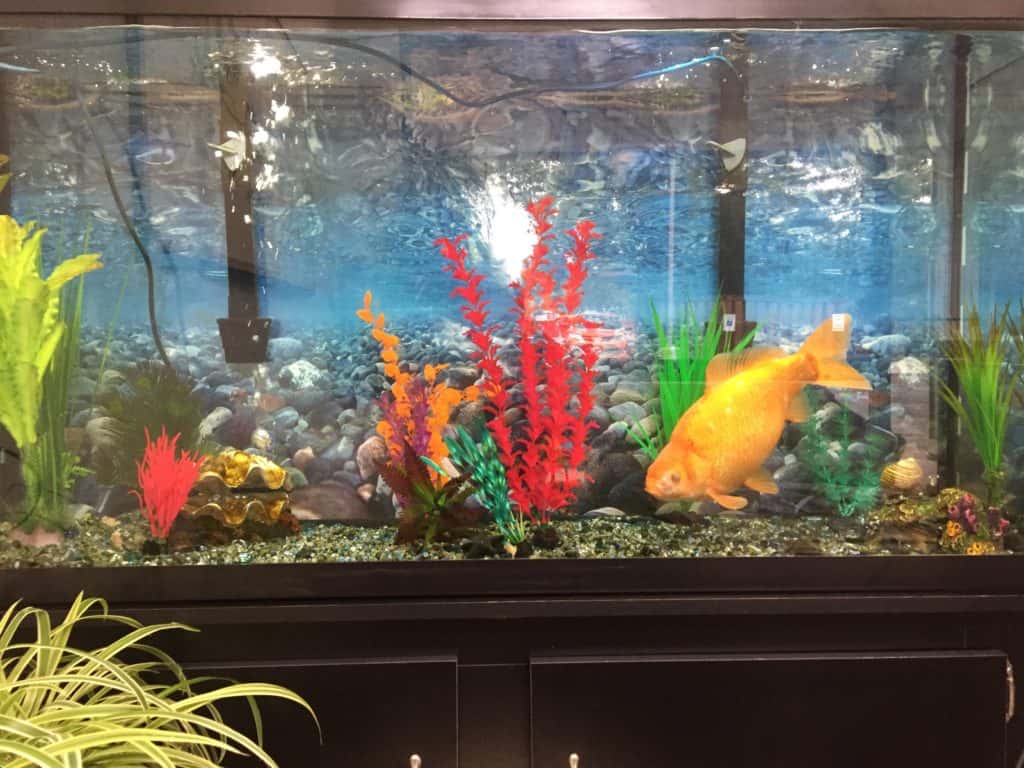Many people will say that some fish, goldfish in particular, will “grow to the size of their container.” Unfortunately, most fish stunting occurs without the owner even noticing. If given lots of room and food, carp species, including goldfish and koi, have the potential for ridiculous growth, up to 16-20″! Many of the largest goldfish even seen were once pets that were “released” into the wild. (NOTE: NEVER release your pets into the wild. If they manage to survive, they often decimate wild populations.)
So, why does your 10 year old goldfish in a 10 gallon tank never get any bigger?
Well, there are many different factors that contribute to lack of growth in fish. If you are not feeding an appropriate diet, you will see a lack of growth. (It is critical you feed any fish an appropriate diet, toss it after 6 months and store it properly.) If your water chemistry is poor, you have created a chronic stress situation. This feedback loop of hormones stops your fish from growing, reproducing or having good immune function. It is the same reason you get sick after stressing out studying for hard exams.
This chronic stress loop can be set off by many different environmental factors. Water chemistry is one of them, but lack of space to swim freely is another. In a confined or over-stocked environment, this hormone loop is activated, keeping your fish small. Again, the same hormones responsible for keeping your fish “the size of their container” are also responsible for delaying reproduction and a robust immune system.
Depending on your fish’s genetics, even in a chronic stress situation, they may continue to grow, regardless of their environmental constraints. We don’t know enough about these variants in pet fish, but they are better understood in aquaculture species that have specific growth requirements for their production. We see this in larger fish, such as koi, who start to show kinks in their spines as they grow bigger in small system. Despite the negative feedback loop, something isn’t completely shutting off their growth, leading to a fish that will continue to suffer in a small space.
Can the effects of fish stunting be treated?
Thankfully, when moved to a larger system, we have seen these spines shift and straighten. Larger, more mature fish may not resolve entirely. Younger, smaller fish have a chance at a full recovery if they are moved. Certainly, the longer a fish remains in a stunting environment, the less likely they will make a full recovery. As soon as you see signs of stunting, make plans to move your fish.
How do I prevent fish stunting?
By limiting your fish’s tank or pond size, you may be hurting their long term thriving capabilities. There are not enough scientific studies done in pet fish to prove this, at this time, but the same hormones are put into play. (And let’s not get started on how your fish should never be in a bowl.) When you adopt a fish, you have to work with their requirements, they aren’t required to work within whatever parameters you deem “acceptable” or have available at the time. As we state in our “How Many Fish Per Gallon” article, the 1″ of fish per gallon rule is completely bogus. Goldfish need 20 gallons PER FISH and may require up to 100 gallons PER FISH as they grow. Koi require 250 gallons PER FISH and up to 500 gallons per reproductively active female. If you can’t fit the volume requirements, DON’T GET THE FISH!
Other Articles You Might Like
Visit our YouTube Page for our new Fish Facts Video Series!


Pingback: Can Fish Die If The Tank Is Too Small? — Angelfish Facts
Pingback: Do Angelfish Need Hiding Spots? — Angelfish Facts
I have raised fish in a dam of 100×600 meters for a year but they have not grown more than 2 inches .
Its tilapia but I have not been feeding them .
What can I do?
If you are concerned about your fish, please call (831) 278-1081 for veterinary assistance. If you are outside California and Nevada, please visit https://fishvets.org or https://wavma.org.
Pingback: 8 Goldfish Myths & Misconceptions: Are the Rumors Real? | Hepper
Pingback: What Happens When You Overstock Your Fish Tank?
Pingback: Best Size Fish Tank For Beginners (2023) - Ultimate Guide
Pingback: Goldfish Tank Size Guide: Everything You Need To Know
Pingback: How Big Do Shubunkin Goldfish Grow To? Factors, Diet & FAQ | Hepper